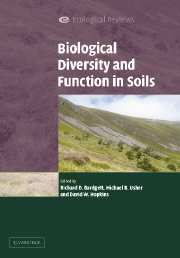Book contents
- Frontmatter
- Contents
- List of contributors
- Preface
- Acknowledgements
- PART I Introduction
- PART II The soil environment
- 2 The habitat of soil microbes
- 3 Twenty years of molecular analysis of bacterial communities in soils and what have we learned about function?
- 4 Carbon as a substrate for soil organisms
- PART III Patterns and drivers of soil biodiversity
- PART IV Consequences of soil biodiversity
- PART V Applications of soil biodiversity
- PART VI Conclusion
- Index
- References
3 - Twenty years of molecular analysis of bacterial communities in soils and what have we learned about function?
Published online by Cambridge University Press: 17 September 2009
- Frontmatter
- Contents
- List of contributors
- Preface
- Acknowledgements
- PART I Introduction
- PART II The soil environment
- 2 The habitat of soil microbes
- 3 Twenty years of molecular analysis of bacterial communities in soils and what have we learned about function?
- 4 Carbon as a substrate for soil organisms
- PART III Patterns and drivers of soil biodiversity
- PART IV Consequences of soil biodiversity
- PART V Applications of soil biodiversity
- PART VI Conclusion
- Index
- References
Summary
SUMMARY
Soils support a taxonomically and physiologically diverse biota widely regarded as more extensive than that of any other group of organisms. However, the limits of this diversity and its importance in delivering soil function remain unclear.
The last 20 years have seen renewed interest in soil microbiology and in the application of molecular methods to explore what is there and how it changes over time or in response to environmental stimuli. For the first time microbiologists have been able to open the microbial ‘black box’ in soils.
The justification often given for opening this ‘black box’ is that the diversity of the contents therein is vitally important to the maintenance and sustainability of the biosphere. However, despite almost 20 years of detailed sifting through the box contents, there is little evidence to support this, suggesting that many of the thousands of microorganisms in soils are functionally redundant and that many of the major functions of the microbial biomass are unaffected by its exact species composition.
This chapter looks at some of the approaches used to open the microbial ‘black box’ and discusses whether we are any closer to understanding the relationship between diversity and function in soils.
Introduction
Soils are an important natural resource and have a key role in the biosphere with most of the annual carbon and nutrient fluxes occurring in the top 5–10 cm of the soil profile.
- Type
- Chapter
- Information
- Biological Diversity and Function in Soils , pp. 44 - 56Publisher: Cambridge University PressPrint publication year: 2005
References
- 14
- Cited by



